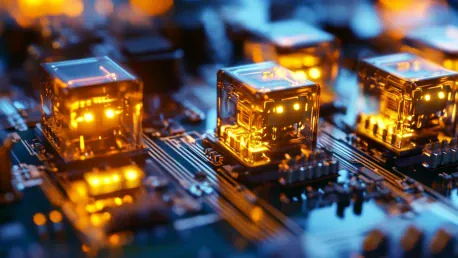In the relentless quest to push the boundaries of artificial intelligence (AI) and neuromorphic computing, researchers are exploring the potential of programmable iontronic neural networks. This cutting-edge technology merges principles from both biological neurons and lithium-ion batteries, creating sophisticated memristors capable of performing advanced neuromorphic functions. The primary focus of this groundbreaking work is constructing iontronic memristors that can leverage functionalities observed in biological neural networks and rechargeable batteries. By doing so, scientists aim to advance AI and neuromorphic computing to new heights, achieving systems that more closely emulate the remarkable capabilities of the human brain.
Transformative Impact of AI
Artificial intelligence has become an exceedingly transformative force, impacting various aspects of daily life, from content generation and supply chain optimization to financial management, language processing, and automated vehicles. The endless possibilities AI offers have resulted in rapid advancements, with leading technology companies making substantial investments in the pursuit of artificial general intelligence (AGI). These advancements aim to develop AI models that are resource-intensive in terms of data, hardware, and energy costs. It’s typically observed that larger models, which consume more resources, generally exhibit superior AI capabilities.
Drawing parallels with the human brain, the complexity of approximately 100 billion neurons and 100 trillion synapses allows for tasks that surpass those possible by simpler organisms, such as mice. This biological sophistication is mirrored in the advanced AI models being developed, notably in the area of language processing. AI models such as GPT-3 and GPT-4 feature billions to trillions of parameters and are frequently compared to the human brain’s cerebrum, which is responsible for logical thinking and language processing. In such ways, AI researchers seek to create machines that can replicate human cognitive abilities in various domains.
Despite impressive advancements seen in large language models like GPT-3 and GPT-4, scaling up AI models to achieve AGI presents colossal resource consumption challenges. The human brain, with its relatively low power consumption of no more than 10 watts, demonstrates an efficiency that modern AI still struggles to match. This efficiency is a critical factor as AI moves forward because it provides a benchmark for developing more energy-efficient AI units capable of performing complex tasks.
Neuromorphic Computing Efficiency
Understanding the human brain’s efficiency in performing tasks despite its low power consumption leads to a detailed examination of iontronic neuromorphic computing. This research leverages the slower yet efficient ionic processing mechanisms observed in biological brains, aiming to create configurable iontronic platforms that integrate the motion of ions into memristors. These components are crucial for building analog AI architectures that closely mimic biological processes.
The concept of iontronic neuromorphic computing involves using configurable iontronic platforms that can harness the natural motion of ions. Specifically, memristors—semiconductors whose resistance varies based on their memory of past voltage—play a pivotal role. These elements are CMOS-compatible, making them suitable for integration with existing microelectronic technologies. By emulating the brain’s efficient information processing through bio-synapse-like gated ionic channels, iontronic memristors have the potential to revolutionize AI efficiency and capability.
Constructing these memristors in a “battery-like” configuration is a significant advancement. By applying the principles of ion motion utilized in rechargeable batteries, these devices can controllably inject and extract lithium ions from the memristor’s switching layers via solid-state electrolytes. This process changes conductance in a manner that mimics biological synapses. These memristors’ capability for volatile conductance changes after excitation points to their potential in emulating short-term memory and spike-timing-dependent plasticity, crucial features in biological neural networks.
Revolutionary Iontronic Memristors
The development of memristors using principles akin to rechargeable batteries marks a notable step forward in neuromorphic computing. By enabling the controlled injection and extraction of lithium ions from the memristor’s switching layers via solid-state electrolytes, these “battery-like” configurations bring radical changes to AI capabilities. The consequent conductance changes resemble those of biological synapses’ behavior, further advancing neuromorphic function replication.
Such memristors’ ability for volatile conductance change after excitation illustrates their prospective role in mimicking short-term memories and spike-timing-dependent plasticity. These characteristics are indispensable for achieving efficient information processing in AI models. Should these memristors manage to mirror such features successfully, the efficiency and capability of AI systems could see unprecedented enhancement. This leap in memristor technology could potentially revolutionize the way we approach AI and its applications across diverse disciplines.
Moreover, these advanced memristors also demonstrate the potential to transition into non-volatile versions through a specific forming process. This transformation allows them to store information either analogly or digitally, which is analogous to how the brain stores long-term memory. The integration of these memristors with mature CMOS technology points to significant advancements by leveraging foundational work in microelectronics. Such a move ensures the bridging of cutting-edge neuromorphic computing technology with established, reliable electronic systems.
Long-Term Memory and Integration
The ability of memristors to transition into non-volatile versions through a careful forming process is revolutionary. These devices can store information analogly or digitally, much like the retention of long-term memory in the brain. This parallel with human memory storage underscores the significant potential for enhancing AI models’ memory capabilities. Their seamless integration with mature CMOS technology takes advantage of foundational microelectronics work, ensuring reliable and effective implementation.
Envisaging an idealized architecture, the concept of ion-enhanced memristors residing on CMOS platforms to form extensive neural networks becomes a reality. Each network node can be individually programmed to suit specific applications. Such a setup paves the way for developing field-programmable neural network arrays that could mimic the complexity and functionality of the human brain. This advanced architecture represents a significant stride towards realizing general AI capabilities while maintaining energy and resource efficiency.
The speculative vision includes creating a fully connected array that mirrors the brain’s complexity, despite current technological limitations. The overarching trend in AI is toward developing more generalized capabilities driven by rapid advancements in nanotechnology, renewable energy technology, and quantum technology. These converging fields act as critical enablers for groundbreaking advancements in computing and AI, furthering the evolution towards more efficient and capable systems.
Potential and Future Visions
In the relentless pursuit of advancing artificial intelligence (AI) and neuromorphic computing, explorers are delving into the potential of programmable iontronic neural networks. This avant-garde technology marries principles from biological neurons with those of lithium-ion batteries, resulting in highly sophisticated memristors capable of performing complex neuromorphic functions. The primary goal of this pioneering research is the creation of iontronic memristors that can capitalize on functionalities observed in both biological neural networks and rechargeable batteries. By combining aspects of both systems, scientists aim to propel AI and neuromorphic computing to unprecedented levels, creating configurations that better mimic the extraordinary abilities of the human brain. This approach could lead to significant advancements in achieving systems that are more efficient, adaptive, and capable of learning in a manner much like human cognition. Through this innovative intersection of biology and technology, the future of AI and neuromorphic computing holds immense promise for transformational breakthroughs.









